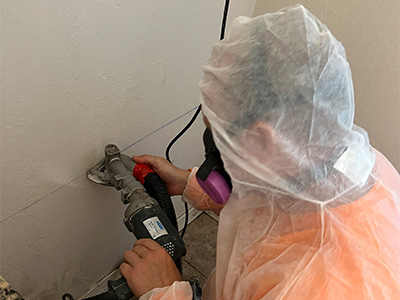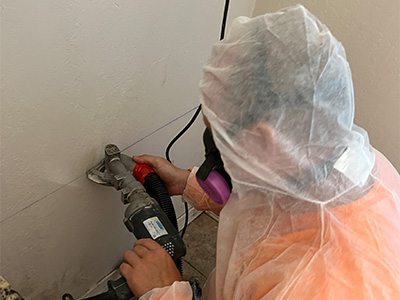What is asbestos, and why is it dangerous? Asbestos was once celebrated for its remarkable insulation properties, but is now infamous for the grave health risks it poses. This fibrous mineral was widely used for decades, only to be discovered as a silent threat lurking in countless structures. In this article, we’ll answer the question “what is asbestos, why is it dangerous, and what to look out for today”.
Table of Contents
Asbestos as a Mineral
Asbestos is a naturally occurring mineral renowned for its unique physical properties. Composed of thin, fibrous crystals, asbestos possesses exceptional heat resistance, durability, and insulating qualities. Its microscopic fibers are highly flexible and resistant to fire, making it an ideal choice for a wide range of applications. Asbestos’s remarkable thermal stability allows it to withstand extreme temperatures, while its resistance to chemical degradation further enhances its longevity.
The History of Asbestos
Uses and Properties
The history of asbestos as a useful material is a tale that spans millennia. It was prized for its exceptional fire-resistant, insulating, and durable qualities. The ancient Greeks named it “asbestos,” meaning “inextinguishable” or “indestructible,” a testament to its enduring properties. Over the centuries, asbestos found its way into an astonishing array of products and applications.
The versatility of asbestos led to its extensive use in construction materials, textiles, and industrial applications. It was employed in the creation of everything from ancient Egyptian burial cloths to modern-day buildings. Asbestos was incorporated into a variety of products, including roofing materials, insulation, floor tiles, cement, and even clothing.
Discovery of Toxicity and Banning
Despite its widespread use and acclaim, asbestos concealed a grim secret. In the early 20th century, a growing number of reports began to emerge linking asbestos exposure to severe health issues. Researchers identified a disturbing connection between asbestos and debilitating lung diseases, particularly mesothelioma, a rare and aggressive form of cancer.

These findings set off a chain reaction of regulatory responses around the world. Governments and health organizations began to recognize the devastating health risks associated with asbestos exposure. As a result, many countries initiated measures to restrict, regulate, or outright ban the use of asbestos in various products.
In the United States, for example, the Environmental Protection Agency (EPA) began phasing out asbestos-containing products in the 1970s. As a result, its use has significantly declined. Nevertheless, the legacy of asbestos still lingers in countless older structures, posing a persistent danger to those who may come into contact with it.
What is Asbestos' Level of Toxicity?

The primary danger of asbestos lies in the way its microscopic fibers can be inhaled into our lungs. These fibers, often released when asbestos-containing materials are disturbed or deteriorate over time, are virtually invisible to the naked eye. Once inside our lungs, they embed themselves deep within the delicate lung tissue, wreaking long-term damage.
One of the most insidious aspects of asbestos exposure is its latency period. It can take years, even decades, for asbestos-related diseases to manifest. This delayed onset makes it challenging to connect current health issues to past exposure, resulting in delayed diagnoses and missed opportunities for early intervention.
Exposure to asbestos can cause several severe health conditions, including:
Lung Cancer: Prolonged exposure to asbestos significantly elevates the risk of developing lung cancer. This risk is even greater when smoking is added into the mix.
Asbestosis: This chronic lung disease results from the scarring of lung tissue due to asbestos fibers. It can cause shortness of breath, persistent coughing, and reduced lung function. While asbestosis is incurable, it usually doesn’t progress unless it is agitated by smoking.
Mesothelioma: A rare and aggressive form of cancer, mesothelioma primarily affects the lining of the lungs, abdomen, or heart. It is almost exclusively caused by asbestos exposure and often carries a poor prognosis, even when compared to other kinds of cancer.
Where is Asbestos Found?
Asbestos can still be found in many older buildings and homes. Common locations include:
Wall Insulation: In many older homes, asbestos was used as insulation material within walls. The purpose was to provide thermal protection and fire resistance. While this insulation may be out of sight, it can still pose risks if disturbed.
Vinyl Floors: Some vinyl floor tiles and the adhesives used to secure them contain asbestos. Homes constructed before the 1980s are more likely to have these materials.
Old Roof Shingles: Asbestos-containing roofing materials, such as shingles and felts, were commonly used for their durability and fire resistance. Homes with older roofs may still have asbestos-based shingles in place.

Around Wood Burning Stoves: Asbestos paper or cement sheets were often used as heat shields around wood-burning stoves or furnaces. While these materials were meant to enhance safety, they can now present health risks.
Pipe Insulation: Asbestos was widely used to insulate pipes, especially in older buildings. The fibrous insulation helps regulate temperature and prevent heat loss. However, over time, these materials can deteriorate, potentially releasing asbestos fibers..
When Do I Know When Something is Made From Asbestos?
One way to gauge the potential presence of asbestos is by considering the age of the building or material. Structures built before the 1980s are more likely to contain asbestos-containing materials. However, just because something is old doesn’t necessarily mean it has asbestos. Newer installations can sometimes contain asbestos as well, but usually in low amounts.
The most accurate way to determine whether a material contains asbestos is to have it tested by a certified asbestos inspector. These professionals can safely collect samples and provide a definitive answer. Asbestos testers usually take about a day to determine whether a sample contains asbestos.
Dealing with Asbestos-Containing Materials
Leave It Undisturbed
If you suspect that asbestos-containing materials are present in your home, the best course of action in the short term is often to leave them undisturbed, as long as they are in good condition and not deteriorating. Asbestos becomes hazardous when it begins to release fibers into the air, so keeping it intact and sealed is crucial.
Professional Removal
When you find asbestos in your home, it is essential to hire a licensed asbestos removal professional. Attempting to remove asbestos yourself is dangerous and illegal.
Proper Disposal
Asbestos waste must be handled and disposed of properly to prevent further contamination. Licensed professionals are equipped to safely transport and dispose of asbestos-containing materials in accordance with local regulations.

Asbestos may be a relic of our industrial past, but its dangers persist in countless structures across the globe. It is our responsibility to remain vigilant and informed about the potential presence of asbestos, especially in older buildings. By understanding its history, recognizing its dangers, taking appropriate precautions, and adhering to professional advice, we can protect ourselves and future generations from the perils of this once-celebrated, now-infamous mineral.
Your health is paramount, and staying asbestos-aware is a vital step in ensuring a safer environment for all. By learning from the past and acting responsibly in the present, we can mitigate the legacy of asbestos and prevent further harm from this hidden danger. Together, we can make our homes and workplaces safer and healthier places to be.


